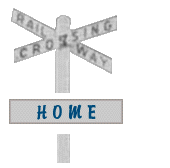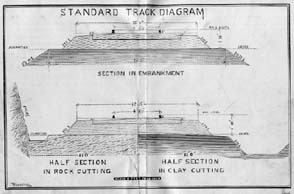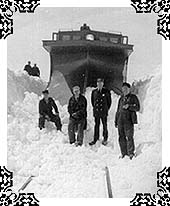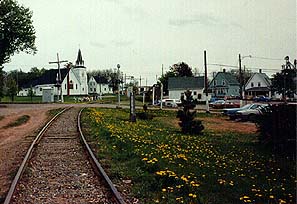








The P.E.I. Railway was started by the Island government in 1871, but the debt-riddled construction was taken over by the Dominion government in 1873 as part of the colony's entry into Confederation. The main line was complete by 1875, and the building of a branch line stretching from Souris to Tignish-- the two communities at located on opposite tips of our crescent-shaped Island-- was begun in 1872. By 1880, there were two trains running daily across the province, one eastbound and the other westbound. But the completion of these lines did not mark the end of railway-building on the Island, as changes to transportation systems made the process of tearing up rails and laying down new ones into a seemingly never-ending one. In 1885, the line was up and running between Emerald Junction and Cape Traverse, the port from which the steam ferries sailed out across the Northumberland Strait. But this route was abandoned soon after new ice-breaking ferries were introduced at Borden in 1917, as these boats were capable of taking on railway cars and transporting them to the mainland. Unfortunately, this development was not one which the original railway contractors had foreseen, and the Island paid dearly for the oversight.
 The
problem was that the P.E.I. Railway had been built with
narrow gauge rails (3' 6") instead of the standard
gauge (4' 8"), as the smaller rail system was
cheaper and the Island was a self-contained line which--
at the time-- only had to be concerned with its own
standards. But the cost-cutting measure ended up costing
far more than it ever saved. If the Island wanted to take
advantage of the new ferries, they would have to use cars
which ran on the same standard gauge as the mainland. And
if they wanted to get these cars to Borden, they would
have to lay down a new set of 4' 8" rails on the
Island. Between this narrow-gauge incompatibility, and
the massive cost overruns of the original construction,
the P.E.I. Railway did not quite live up to its advance
billing as an economic boon.
The
problem was that the P.E.I. Railway had been built with
narrow gauge rails (3' 6") instead of the standard
gauge (4' 8"), as the smaller rail system was
cheaper and the Island was a self-contained line which--
at the time-- only had to be concerned with its own
standards. But the cost-cutting measure ended up costing
far more than it ever saved. If the Island wanted to take
advantage of the new ferries, they would have to use cars
which ran on the same standard gauge as the mainland. And
if they wanted to get these cars to Borden, they would
have to lay down a new set of 4' 8" rails on the
Island. Between this narrow-gauge incompatibility, and
the massive cost overruns of the original construction,
the P.E.I. Railway did not quite live up to its advance
billing as an economic boon.
Even so, the building of this railway system was a massive feat of engineering, which required the hard work and sweat of hundreds of Islanders. Five main components were used in the construction of the tracks themselves: rails, ties, spikes, ballasts, and subgrade. The rails consisted of the steel lengths bolted or welded together to form the running surface for the train. The subgrade was the solid ground used as a base, which was then covered by the ballast, the large amount of rock material that comprised the actual rail bed. Millions and millions of tons of mainland gravel had to be shipped across the Northumberland Strait to serve as the ballast, as Island sandstone was too fragile to fit the bill. The ties were almost always wood, but were also sometimes made of concrete. The rails were fastened to the tie with spikes, which provided the proper gauge and also helped distribute the stress properly on the ballast layer.
P.E.I.'s weak bedrock-- the red sandstone-- made maintaining the rail lines a constant battle, as the tracks were not resting upon the most solid of foundations. When the spring thaw arrived and the frost heaves left the ground, the tracks would become an Island-wide obstacle course of buckles and dips, which proved highly problematic for trains designed to travel over level surfaces. The process of fixing the tracks was every bit as intensive as the modern-day ritual of filling potholes on the roads, and just as continuous.
 One important position
with regard to railway maintenance was that of the track
master, who made monthly inspections of the section--
riding on a hand-car or from the back of a train-- and
would submit written reports on its condition. However,
the day-to-day upkeep of the line fell to the track
foreman and workers, who were the front-line people
responsible for the safe passage of trains. The foreman
would walk over his section every morning and inspect it
closely, and he would take many tools and parts along
with him, as missing bolts, loose nuts, and broken spikes
had to be remedied immediately. Oftentimes, the
unpredictable rail beds required quite a bit of
improvisation and quick thinking on his part. Shims were
placed under rails which had started to dip; his book of
regulations stated that "in no case are Shims
thicker than three inches to be used". This rule
book also stated that, when an animal was fatally wounded
by the train, he was to end its suffering and have it
removed post haste.
One important position
with regard to railway maintenance was that of the track
master, who made monthly inspections of the section--
riding on a hand-car or from the back of a train-- and
would submit written reports on its condition. However,
the day-to-day upkeep of the line fell to the track
foreman and workers, who were the front-line people
responsible for the safe passage of trains. The foreman
would walk over his section every morning and inspect it
closely, and he would take many tools and parts along
with him, as missing bolts, loose nuts, and broken spikes
had to be remedied immediately. Oftentimes, the
unpredictable rail beds required quite a bit of
improvisation and quick thinking on his part. Shims were
placed under rails which had started to dip; his book of
regulations stated that "in no case are Shims
thicker than three inches to be used". This rule
book also stated that, when an animal was fatally wounded
by the train, he was to end its suffering and have it
removed post haste.
 When
the trackman discovered these types of hazards, he would
use a system of red, green, and white signals to alert
train personnel and-- most importantly-- oncoming trains.
Red meant danger ahead; green indicated caution, proceed
slowly; and white meant that all was right, go on. The
signals were made with flags in the daytime, and at
night, with lanterns or even torpedoes. The rules
explicitly barred track foremen from wearing red on the
job, as even a glimpse of that color would set a train on
high alert. In the winter, these trackmen waged a battle
against the accumulation
of snow on the rails, and advised
the trackmaster continually about its depth, even on
Sundays. Teams of snow shovellers were hired to clear the
massive drifts, and tragically, these men were
occasionally killed by unexpected trains. The engines
could not see around their plows, and the snow cuttings
were sometimes too high for the men to climb out on time.
When
the trackman discovered these types of hazards, he would
use a system of red, green, and white signals to alert
train personnel and-- most importantly-- oncoming trains.
Red meant danger ahead; green indicated caution, proceed
slowly; and white meant that all was right, go on. The
signals were made with flags in the daytime, and at
night, with lanterns or even torpedoes. The rules
explicitly barred track foremen from wearing red on the
job, as even a glimpse of that color would set a train on
high alert. In the winter, these trackmen waged a battle
against the accumulation
of snow on the rails, and advised
the trackmaster continually about its depth, even on
Sundays. Teams of snow shovellers were hired to clear the
massive drifts, and tragically, these men were
occasionally killed by unexpected trains. The engines
could not see around their plows, and the snow cuttings
were sometimes too high for the men to climb out on time.
As the years passed, the tracks were travelled
less and less frequently on the Island, and on December
31, 1989, the last part of the railway was abandoned by
CN Rail. Slowly but surely, the once-proud rail system
began to be ripped up and sold for scrap. However, the
extensive system of rail beds was built to last, and
plans have been assembled to put it to good use. The
abandoned rail lines  are being converted
into a section of the nation-wide Confederation Trail, a
network of hiking, biking, and snowmobiling trails that--
when completed-- will stretch from coast to coast. Today,
the former railway line between Kensington and Summerside
not only promotes the health and well-being of the
community, but also represents one part of an important
project for knitting the country together, as the railway
did for so long.
are being converted
into a section of the nation-wide Confederation Trail, a
network of hiking, biking, and snowmobiling trails that--
when completed-- will stretch from coast to coast. Today,
the former railway line between Kensington and Summerside
not only promotes the health and well-being of the
community, but also represents one part of an important
project for knitting the country together, as the railway
did for so long.
